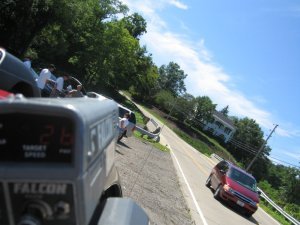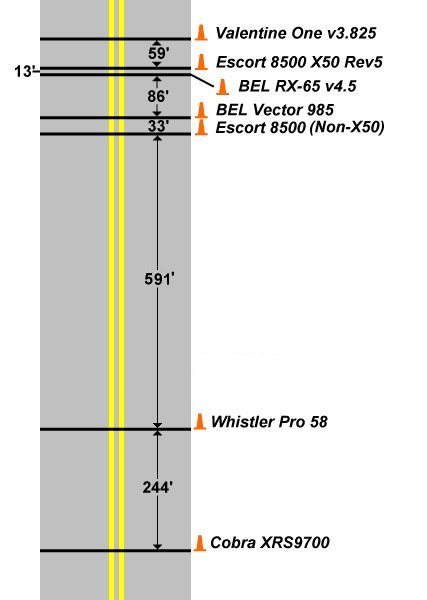

 When it came time to do our detector tests, time was short and we knew that we wouldn't be able to be as thorough as we would have liked. We knew we needed to do a real-world type of test that would have the most merit in the whole scheme of things. So with assistance from Certified LEO #1, a test course was carefully selected that would closely emulate the way a real-world speed trap might be set up. The test course included a hill and a small curve, which would not only provide good cover for an officer running radar in a real-world scenario, but in the case of our testing, would also provide a good indication of the different performance characteristics of the detectors.
When it came time to do our detector tests, time was short and we knew that we wouldn't be able to be as thorough as we would have liked. We knew we needed to do a real-world type of test that would have the most merit in the whole scheme of things. So with assistance from Certified LEO #1, a test course was carefully selected that would closely emulate the way a real-world speed trap might be set up. The test course included a hill and a small curve, which would not only provide good cover for an officer running radar in a real-world scenario, but in the case of our testing, would also provide a good indication of the different performance characteristics of the detectors. The radar units used were the Kustom Golden Eagle (Ka - 35.5 GHz), the Kustom Falcon (K), and the MPH K-15 (X). All radar units were operated in a fixed position, not held by hand. The detectors were mounted level, and high on the windshield to provide a clear view of the road ahead. The test vehicle drove towards the radar very slowly, and determined the point of the first alert from the radar detector. A cone was then labeled with the name of the detector and placed on the side of the road (at the same point that the detector was mounted in the vehicle). After a cone was placed for each detector being tested, the distance between the cones was measured by Certified LEO #1 using the Kustom ProLaser III, and the results were recorded. The test vehicle was alerted via radio to other approaching vehicles, so that no other vehicles were on the course when the points of first alert were being determined.
The radar units used were the Kustom Golden Eagle (Ka - 35.5 GHz), the Kustom Falcon (K), and the MPH K-15 (X). All radar units were operated in a fixed position, not held by hand. The detectors were mounted level, and high on the windshield to provide a clear view of the road ahead. The test vehicle drove towards the radar very slowly, and determined the point of the first alert from the radar detector. A cone was then labeled with the name of the detector and placed on the side of the road (at the same point that the detector was mounted in the vehicle). After a cone was placed for each detector being tested, the distance between the cones was measured by Certified LEO #1 using the Kustom ProLaser III, and the results were recorded. The test vehicle was alerted via radio to other approaching vehicles, so that no other vehicles were on the course when the points of first alert were being determined. We also tested two "previous generation" detectors to see how they compare to current units. These were the the Escort 8500 (Non-X50) and the BEL Vector 985. |




